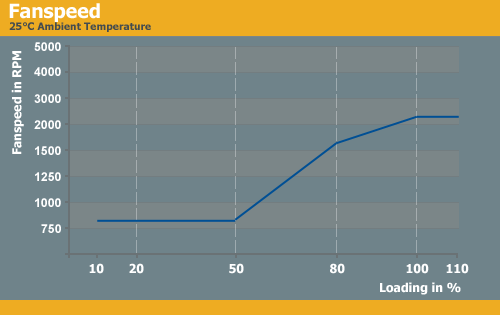Seasonic M12D 850W: DC-to-DC Perfection?
by Christoph Katzer on November 26, 2008 12:00 AM EST- Posted in
- Cases/Cooling/PSUs
Temperatures, Fan Speed, and Acoustics

The temperature results of the Seasonic M12D are another area where it excels, surpassing most other power supplies. When you compare the temperatures to the increasing speed of the fan, you can clearly see how well the design works. Many other power supplies ramp up fan speed even when it's not necessary, and frequently higher fan speeds and increased airflow barely manage to keep temperatures in check. In contrast, the M12D stays under 50°C at all times; there's a jump in temperature on the secondary heatsink between 20% and 50% load, but it's not enough to actually require a significant increase in fan speed. Once the fan does begin to speed up, however, we immediately see temperatures begin to fall off, showing that the heatsinks are working exceptionally well.

With loads of up to 50%, power output generally stays below 400W and this power supply is virtually silent. Only beyond 50% load is the fan begin to kick in, and as we saw above it does a good job at keeping temperatures in check, reaching a maximum 2300RPM. Seasonic is a bit conservative at higher loads, since the temperatures are still more than reasonable, but they are proud of the engineering that has gone into this design.

At maximum loads and fan speeds of 2300 RPM, it's no surprise that noise levels aren't great. Maximum acoustic noise reaches 31dB(A), which you can definitely hear -- although as usual, creating a load of 850W generally means a lot of noisy graphics card and CPU fans as well. Seasonic prefers to take a conservative approach and avoid overheating, which is good for end-users and component longevity. Given that few users will put such a heavy load on their PSU, however, noise levels of only 17dB(A) at up to 400W are practically undetectable -- it's definitely at the lower boundary of what our equipment can measure. There is however a small ticking noise that can be heard from the heavily undervolted fan, which is common with fans that used normal voltage regulation instead of a PWM controller. (Antec has the patent for PWM controllers in PSUs.)










45 Comments
View All Comments
CEO Ballmer - Saturday, November 29, 2008 - link
I have one, works nicely!http://fakesteveballmer.blogspot.com">http://fakesteveballmer.blogspot.com
InterClaw - Friday, November 28, 2008 - link
How much power does the M12D consume while in standby mode (switch on) running on 230Vac?Christoph Katzer - Saturday, November 29, 2008 - link
I will have a small update on that because I did some further testing. The M12D has an incredible high sb-efficiency with up to 76% which is really good compared to 40-ish% of many others.daar - Wednesday, November 26, 2008 - link
Can someone explain the significance for the DC-to-DC configuration over what they or other PSU manufacturers normally do? I mean other than the odd efficiency curves, it doesn't really provide anything unique when compared to say, the Enermax.PrinceGaz - Wednesday, November 26, 2008 - link
I'm guessing here and haven't checked my "facts", but I'm guessing the DC-DC conversion helps because it allows the PSU manufacturer to concentrate most of their effort on providing a clean and efficient +12V rail from the AC supply, then tag the conversion circuitry onto the end of that to generate the less critical +5V and +3.3V rails.The alternative is to have seperate circuitry for generating +12V, +5V, and +3.3V all individually from the AC supply.
JarredWalton - Thursday, November 27, 2008 - link
I believe that's right - it's easier to do 12V DC to 3.3V/5V DC than it is to do 120V/230V AC to the same, so you do one good AC-to-DC conversion and then a couple simpler DC-to-DC conversions.mindless1 - Saturday, November 29, 2008 - link
It's not necessarily easier, it's just that if you first convert to 12V alone you have maximized the amount of 12V current a single transformer of a given size can produce, then let that be the primary feedback voltage to determine switching pulse width. That typically also means you can have higher ratios of 12V to 5V or 3.3V current without going out of spec. It makes more and more sense to do so when a PSU is of high wattage as it's then expected to have so much more 12V current consumption as a % of total power used.Mr Perfect - Wednesday, November 26, 2008 - link
Maybe you could put a bug in Seasonic's ear about their "little" 120mm fan? Looking at the acoustic results, you can't help but wonder what a 140mm fan could have done for that curve. A 140mm might have shifted the whole curve down two or three decibels.piroroadkill - Thursday, November 27, 2008 - link
Bear in mind half of the fan is usually covered towards the front of the PSU, I'm really not sure a 140mm fan helps at all, because that's simply more airflow that's blocked by a baffle. This baffles me (hurr)... Seems like 120mm is perfectly adequete, and more to the point, if you so wish to change the fan yourself, at least 120mm is a standard sizeMr Perfect - Thursday, November 27, 2008 - link
140s are mainly interesting because they produce any given amount of airflow at a lower RPM then 120s. So rather then run it at the same RPM as the 120, and just block more airflow, they could run it at a lower RPM while producing the same airflow. Then maybe it would top out around 28DB instead of a 31DB, or idle at 15db instead of 17. Hopefully there wouldn't be a need to change the fan then.